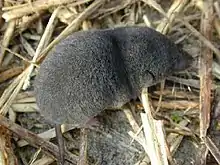Blarina
The genus Blarina is a group of relatively large shrews with relatively short tails found in North America.
This article is about the shrew. For the fictional species from Star Wars, see List of Star Wars species (A–E) § Blarina.
| American short-tailed shrews[1] Temporal range: Late Pliocene to Recent | |
|---|---|
 | |
| Southern short-tailed shrew (Blarina carolinensis) | |
| Scientific classification | |
| Domain: | Eukaryota |
| Kingdom: | Animalia |
| Phylum: | Chordata |
| Class: | Mammalia |
| Order: | Eulipotyphla |
| Family: | Soricidae |
| Tribe: | Blarinini |
| Genus: | Blarina Gray, 1838 |
| Type species | |
| Corsira (Blarina) talpoides [2] | |
| Species | |
| |
Description
They have 32 teeth and are in the red-toothed shrew subfamily. They generally have dark fur and thick feet. The saliva of these animals is toxic and is used to subdue prey.[3]
Species
Species are:[1]
- Northern short-tailed shrew B. brevicauda
- Southern short-tailed shrew B. carolinensis
- Elliot's short-tailed shrew B. hylophaga
- Everglades short-tailed shrew B. peninsulae
- Sherman's short-tailed shrew B. shermani; possibly extinct[4][5]
Ecoepidemiology
Short-tailed shrews are one of the animal reservoirs of the agents of Lyme disease and human babesiosis.[6]
References
- Hutterer, R. (2005). Wilson, D.E.; Reeder, D.M. (eds.). Mammal Species of the World: A Taxonomic and Geographic Reference (3rd ed.). Johns Hopkins University Press. pp. 269–270. ISBN 978-0-8018-8221-0. OCLC 62265494.
- Wilson, D. E.; Reeder, D. M., eds. (2005). Mammal Species of the World: A Taxonomic and Geographic Reference (3rd ed.). Johns Hopkins University Press. ISBN 978-0-8018-8221-0. OCLC 62265494.
- Kita M, Okumura Y, Ohdachi SD, Oba Y, Yoshikuni M, Nakamura Y, Kido H, Uemura D (February 2005). "Purification and characterisation of blarinasin, a new tissue kallikrein-like protease from the short-tailed shrew Blarina brevicauda: comparative studies with blarina toxin". Biological Chemistry. 386 (2): 177–82. doi:10.1515/BC.2005.022. hdl:2115/7398. PMID 15843162. S2CID 2884850.
- "NatureServe Explorer 2.0". explorer.natureserve.org. Retrieved 2023-03-30.
- "Explore the Database". www.mammaldiversity.org. Retrieved 2023-03-30.
- Telford III, S. R., Mather, T. N., Adler, G. H., & Spielman, A. (1990). Short-tailed shrews as reservoirs of the agents of Lyme disease and human babesiosis. The Journal of parasitology, 681-683 (abstract)
| Taxon identifiers |
|---|
This article is issued from Wikipedia. The text is licensed under Creative Commons - Attribution - Sharealike. Additional terms may apply for the media files.